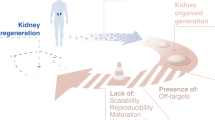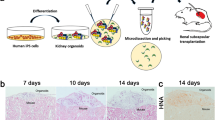Abstract
The steadily growing number of patients with chronic kidney disease who will eventually develop end-stage renal disease, together with the qualitative limitations of currently available renal replacement therapies, have triggered the exploration of innovative strategies for renal replacement therapy and for salvage of renal function. Currently, new hemodialysis modalities and membranes are being used with the aim of increasing clearance of uremic toxins to afford better metabolic control. In addition to these conventional approaches, there are four innovative potential solutions to the problem of replacing renal function when kidneys fail. The first is a small, implantable device with the potential to be supplemented with human cells ('artificial kidney'). The second involves restoration of the damaged kidney by harnessing recent advances in stem-cell technology and knowledge of developmental programing ('refurbished kidney'). The third is (partially) growing a kidney in vitro with the use of therapeutic cloning ('cultured kidney'). The fourth innovative solution involves the use of other organs to replace various renal functions ('distributed kidney'). In this article we review the efforts that have been made to improve renal replacement therapies, and explore innovative approaches. We will not cover all potential solutions in detail. Rather, we aim to indicate directions of future endeavor and arouse enthusiasm in clinicians and scientists for exploration of these exciting avenues.
Key Points
-
Unless conventional dialysis techniques can be considerably improved, the ever-increasing burden of chronic kidney disease will necessitate the development of innovative new renal replacement therapies
-
The use of xenotransplantation continues to be investigated
-
Nanotechnology could be a platform for the development of a lightweight and reliable artificial kidney that could be worn or implanted
-
The integration of new nephrons, repair of native renal tissue by using stem cells derived from bone marrow or kidney, and generation of replacement tissue using nuclear transplantation and embryonic stem cells, are all promising avenues of investigation
-
The 'hosting' of renal functions in nonrenal tissues, and harnessing of developmental plasticity in adults, might also help to overcome kidney dysfunction
This is a preview of subscription content, access via your institution
Access options
Subscribe to this journal
Receive 12 print issues and online access
$209.00 per year
only $17.42 per issue
Buy this article
- Purchase on Springer Link
- Instant access to full article PDF
Prices may be subject to local taxes which are calculated during checkout



Similar content being viewed by others
References
Vanholder R et al. (2005) The European artificial organ scene: present status. Artif Organs 29: 498–506
Humes HD et al. (2006) The future of hemodialysis membranes. Kidney Int 69: 1115–1119
Kooistra MP (2003) Frequent prolonged home haemodialysis: three old concepts, one modern solution. Nephrol Dial Transplant 18: 16–19
Eknoyan G et al. (2002) Effect of dialysis dose and membrane flux in maintenance hemodialysis. N Engl J Med 347: 2010–2019
Penne EL et al. (2005) Resolving controversies regarding hemodiafiltration versus hemodialysis: the Dutch Convective Transport Study. Semin Dial 18: 47–51
Ward RA (2005) Protein-leaking membranes for hemodialysis: a new class of membranes in search of an application? J Am Soc Nephrol 16: 2421–2430
Leonard EF et al. (2004) Dialysis without membranes: how and why? Blood Purif 22: 92–100
Humes HD et al. (1999) Tissue engineering of a bioartificial renal tubule assist device: in vitro transport and metabolic characteristics. Kidney Int 55: 2502–2514
Diaz-Buxo JA (2005) Access and continuous flow peritoneal dialysis. Perit Dial Int 25 (Suppl 3): S102–S104
Hoff CM and Shockley TR (2002) Peritoneal dialysis in the 21st century: the potential of gene therapy. J Am Soc Nephrol 13 (Suppl 1): S117–S124
Kozlowski T et al. (1998) Depletion of anti-Gal(alpha)1-3Gal antibody in baboons by specific alpha-Gal immunoaffinity columns. Xenotransplantation 5: 122–131
McKenzie IF et al. (1999) Definition and characterization of chicken Gal alpha(1,3)Gal antibodies. Transplantation 67: 864–870
Zhong R et al. (2003) Improvement in human decay accelerating factor transgenic porcine kidney xenograft rejection with intravenous administration of gas914, a polymeric form of alphaGAL. Transplantation 75: 10–19
Lai L et al. (2002) Production of alpha-1,3-galactosyltransferase knockout pigs by nuclear transfer cloning. Science 295: 1089–1092
Yamada K et al. (2005) Marked prolongation of porcine renal xenograft survival in baboons through the use of alpha1,3-galactosyltransferase gene-knockout donors and the cotransplantation of vascularized thymic tissue. Nat Med 11: 32–34
Soin B et al. (2001) Physiological aspects of pig-to-primate renal xenotransplantation. Kidney Int 60: 1592–1597
Butler D (1998) Last chance to stop and think on risks of xenotransplants. Nature 391: 320–324
Paradis K et al. (1999) Search for cross-species transmission of porcine endogenous retrovirus in patients treated with living pig tissue. The XEN 111 Study Group. Science 285: 1236–1241
Wilson CA et al. (2000) Extended analysis of the in vitro tropism of porcine endogenous retrovirus. J Virol 74: 49–56
Nissenson AR et al. (2005) The human nephron filter: toward a continuously functioning, implantable artificial nephron system. Blood Purif 23: 269–274
Drexler KE (2003) If atomic precision is unfeasible, so is life. Nature 422: 257
Shin M et al. (2004) Endothelialized networks with a vascular geometry in microfabricated poly(dimethyl siloxane). Biomed Microdevices 6: 269–278
Brodie JC and Humes HD (2005) Stem cell approaches for the treatment of renal failure. Pharmacol Rev 57: 299–313
Atala A and Koh CJ (2004) Tissue engineering applications of therapeutic cloning. Annu Rev Biomed Eng 6: 27–40
Laflamme MA and Murry CE (2005) Regenerating the heart. Nat Biotechnol 23: 845–856
Steer DL and Nigam SK (2004) Developmental approaches to kidney tissue engineering. Am J Physiol Renal Physiol 286: F1–F7
Woolf AS et al. (1990) Creation of a functioning chimeric mammalian kidney. Kidney Int 38: 991–997
Rogers SA et al. (1998) Transplantation of developing metanephroi into adult rats. Kidney Int 54: 27–37
Dekel B et al. (2002) Engraftment and differentiation of human metanephroi into functional mature nephrons after transplantation into mice is accompanied by a profile of gene expression similar to normal human kidney development. J Am Soc Nephrol 13: 977–990
Schmidt-Ott KM et al. (2005) Novel regulators of kidney development from the tips of the ureteric bud. J Am Soc Nephrol 16: 1993–2002
Rookmaaker MB et al. (2002) Bone-marrow-derived cells contribute to endothelial repair after thrombotic microangiopathy. Blood 99: 1095
Cornacchia F et al. (2001) Glomerulosclerosis is transmitted by bone marrow-derived mesangial cell progenitors. J Clin Invest 108: 1649–1656
Imasawa T et al. (2001) The potential of bone marrow-derived cells to differentiate to glomerular mesangial cells. J Am Soc Nephrol 12: 1401–1409
Kale S et al. (2003) Bone marrow stem cells contribute to repair of the ischemically injured renal tubule. J Clin Invest 112: 42–49
Gupta S et al. (2002) A role for extrarenal cells in the regeneration following acute renal failure. Kidney Int 62: 1285–1290
Feng Z et al. (2005) Glomerular aging in females is a multi-stage reversible process mediated by phenotypic changes in progenitors. Am J Pathol 167: 355–363
Oliver JA et al. (2004) The renal papilla is a niche for adult kidney stem cells. J Clin Invest 114: 795–804
Maeshima A et al. (2006) Adult kidney tubular cell population showing phenotypic plasticity, tubulogenic capacity, and integration capability into developing kidney. J Am Soc Nephrol 17: 188–198
Lange C et al. (2005) Administered mesenchymal stem cells enhance recovery from ischemia/reperfusion-induced acute renal failure in rats. Kidney Int 68: 1613–1617
Little MH (2006) Regrow or repair: potential regenerative therapies for the kidney. J Am Soc Nephrol 17: 2390–2401
Choi JH et al. (2004) Decreased number and impaired angiogenic function of endothelial progenitor cells in patients with chronic renal failure. Arterioscler Thromb Vasc Biol 24: 1246–1252
Lin F et al. (2005) Intrarenal cells, not bone marrow-derived cells, are the major source for regeneration in postischemic kidney. J Clin Invest 115: 1756–1764
Duffield JS et al. (2005) Restoration of tubular epithelial cells during repair of the postischemic kidney occurs independently of bone marrow-derived stem cells. J Clin Invest 115: 1743–1755
Thomson JA et al. (1998) Embryonic stem cell lines derived from human blastocysts. Science 282: 1145–1147
Lanza RP et al. (2002) Generation of histocompatible tissues using nuclear transplantation. Nat Biotechnol 20: 689–696
Koh CJ and Atala A (2004) Tissue engineering, stem cells, and cloning: opportunities for regenerative medicine. J Am Soc Nephrol 15: 1113–1125
Okie S (2005) Stem-cell research—signposts and roadblocks. N Engl J Med 353: 1–5
Chung Y et al. (2006) Embryonic and extraembryonic stem cell lines derived from single mouse blastomeres. Nature 439: 216–219
Solter D (2000) Mammalian cloning: advances and limitations. Nat Rev Genet 1: 199–207
Hochedlinger K and Jaenisch R (2003) Nuclear transplantation, embryonic stem cells, and the potential for cell therapy. N Engl J Med 349: 275–286
Tamashiro KL et al. (2002) Cloned mice have an obese phenotype not transmitted to their offspring. Nat Med 8: 262–267
Gluckman PD and Hanson MA (2004) Living with the past: evolution, development, and patterns of disease. Science 305: 1733–1736
Henderson LW (2000) Future developments in the treatment of end-stage renal disease: a North American perspective. Am J Kidney Dis 35 (Suppl S): S106–S116
Bateson P et al. (2004) Developmental plasticity and human health. Nature 430: 419–421
Barker DJ (2004) The developmental origins of well-being. Philos Trans R Soc Lond B Biol Sci 359: 1359–1366
Racasan S et al. (2005) Programming blood pressure in adult SHR by shifting perinatal balance of NO and reactive oxygen species toward NO: the inverted Barker phenomenon. Am J Physiol Renal Physiol 288: F626–F636
Racasan S et al. (2004) Perinatal L-arginine and antioxidant supplements reduce adult blood pressure in spontaneously hypertensive rats. Hypertension 44: 83–88
Lundie MJ et al. (1997) Long-term inhibition of the renin-angiotensin system in genetic hypertension: analysis of the impact on blood pressure and cardiovascular structural changes. J Hypertens 15: 339–348
Smallegange C et al. (2004) Persistent lowering of pressure by transplanting kidneys from adult spontaneously hypertensive rats treated with brief antihypertensive therapy. Hypertension 44: 89–94
Julius S et al. (2006) Feasibility of treating prehypertension with an angiotensin-receptor blocker. N Engl J Med 354: 1685–1697
Acknowledgements
B Braam was supported by a research fellowship from the Royal Netherlands Academy of Arts and Sciences. MC Verhaar is supported by the Netherlands Organization for Scientific Research (NWO grant 016.036.041). Studies cited in this report were supported by the Dutch Kidney Foundation (grants NS6013, C03.2039, PC127 and C04.2093).
Author information
Authors and Affiliations
Corresponding author
Ethics declarations
Competing interests
The authors declare no competing financial interests.
Rights and permissions
About this article
Cite this article
Braam, B., Verhaar, M., Blankestijn, P. et al. Technology Insight: innovative options for end-stage renal disease—from kidney refurbishment to artificial kidney. Nat Rev Nephrol 3, 564–572 (2007). https://doi.org/10.1038/ncpneph0600
Received:
Accepted:
Issue Date:
DOI: https://doi.org/10.1038/ncpneph0600
This article is cited by
-
Langzeitüberleben bei chronischer Niereninsuffizienz
Bundesgesundheitsblatt - Gesundheitsforschung - Gesundheitsschutz (2012)



